The Rufous Hummingbird (Selasphorus rufus) is a charismatic and enchanting bird species that graces the skies of North America with its vibrant presence.
Renowned for its striking plumage and remarkable behaviors, this diminutive hummingbird captures the attention of bird enthusiasts and casual observers alike.
Males boast dazzling hues of orange-red on their throats, while females exhibit a subtle greenish-bronze elegance.
Notable for its extensive migration, the Rufous Hummingbird embarks on one of the longest journeys of any hummingbird species, traversing thousands of miles from its breeding grounds in western North America to wintering areas in Mexico.
With agile flight, intricate courtship displays, and a penchant for defending feeding territories, the Rufous Hummingbird exemplifies the resilience and beauty inherent in the avian world, making it a captivating subject of study and admiration. Stay focused.
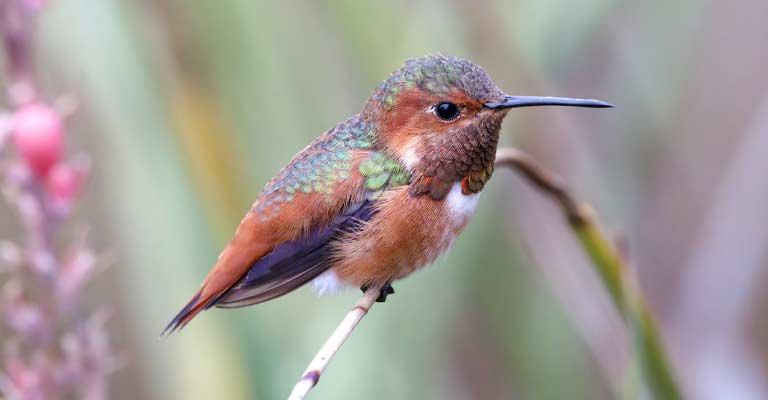
Identifying Characteristics of Rufous Hummingbird
The Rufous Hummingbird (Selasphorus rufus) is a striking and charismatic bird species that captivates birdwatchers with its vibrant plumage and energetic behavior.
Identifying this specific hummingbird involves paying attention to various key characteristics, and here are some points to help you distinguish the Rufous Hummingbird from other species:
Size and Shape
The Rufous Hummingbird is a relatively small bird, measuring about 3 to 3.75 inches (7.5 to 9.5 cm) in length.
Its body is compact, and it has a short, straight bill, typical of hummingbirds. The wings are relatively short and pointed, allowing for rapid and agile flight.
Plumage
One of the most distinctive features of the Rufous Hummingbird is its vibrant plumage. Males are characterized by an orange-red throat (gorget), while females have greenish-bronze plumage.
The rest of the body is generally cinnamon-colored, and the back often exhibits a greenish tint. The plumage can vary slightly among individuals, but the overall coloration is a key identifier.
Tail Feathers
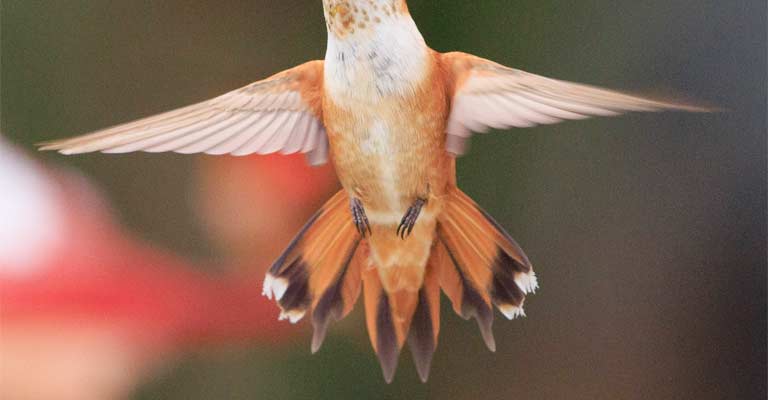
The tail of the Rufous Hummingbird is noteworthy for its long, pointed central tail feathers.
These feathers, called rectrices, extend beyond the rest of the tail and are often iridescent. The length and shape of the tail feathers contribute to the bird’s distinctive appearance.
Territorial Behavior
Rufous Hummingbirds are known for their territorial nature. Males, in particular, vigorously defend feeding territories and are often seen chasing away other hummingbirds, including larger species.
Observing territorial behavior can be a clue that you are observing a Rufous Hummingbird.
Migration Patterns
Rufous Hummingbirds are notable for their extensive migration.
They have one of the longest migration routes of any hummingbird species, traveling from their breeding grounds in western North America to wintering grounds in Mexico.
During migration, they may pass through a variety of habitats, providing opportunities for birdwatchers to spot them.
High-Pitched Vocalizations
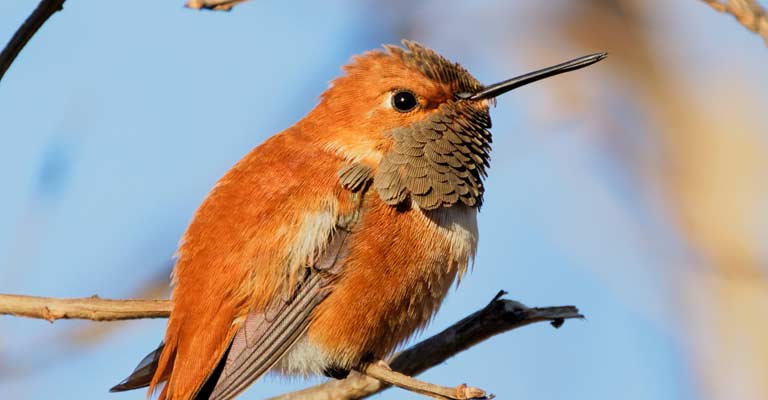
While their vocalizations are not as prominent as their visual characteristics, Rufous Hummingbirds do produce high-pitched, chattering sounds during flight and while perched.
Familiarizing yourself with their distinct vocalizations can enhance your ability to identify them in the field.
Preferred Habitats
Rufous Hummingbirds can be found in a variety of habitats, including gardens, meadows, and forested areas.
They are often associated with flowering plants, from which they obtain nectar. Knowing their preferred habitats can help birdwatchers target specific locations for sightings.
Seasonal Presence
Understanding the seasonal presence of Rufous Hummingbirds is crucial for identification. They are typically present in their breeding territories from spring to late summer, and their migration south occurs in the fall.
Winter sightings in certain regions, especially in the southern parts of their range, may also occur.
Recognizing the Rufous Hummingbird involves a combination of visual and behavioral cues.
By paying attention to their size, plumage, tail feathers, territorial behavior, migration patterns, vocalizations, preferred habitats, and seasonal presence, birdwatchers can confidently identify this enchanting hummingbird species.
Taxonomy of Rufous Hummingbird
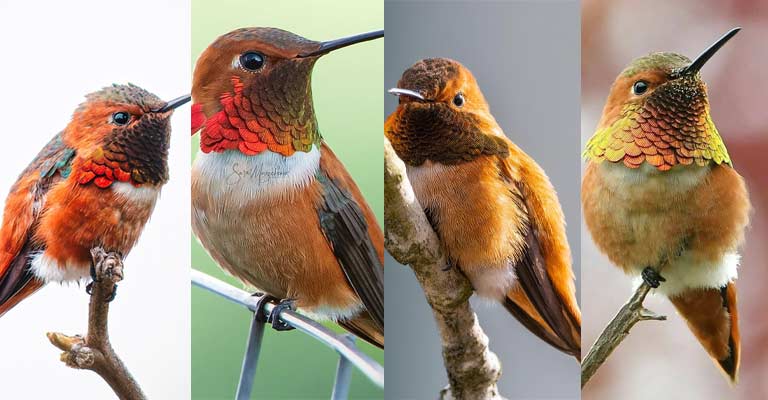
| Taxonomic Level | Classification |
| Domain | Eukaryota |
| Kingdom | Animalia |
| Phylum | Chordata |
| Class | Aves |
| Clade | Strisores |
| Order | Apodiformes |
| Family | Trochilidae |
| Genus | Selasphorus |
| Species | S. rufus |
Its specific epithet, rufus, designates it as the species “rufus” within the Selasphorus genus. This taxonomy highlights the hierarchical classification of the Rufous Hummingbird within the broader spectrum of life.
The Rufous Hummingbird (Selasphorus rufus) is classified under the domain Eukaryota, kingdom Animalia, phylum Chordata, class Aves, and order Apodiformes.
It belongs to the family Trochilidae, renowned for nectar-feeding birds.
Within the avian clade Strisores, the Rufous Hummingbird is further categorized under the genus Selasphorus, specifying its unique traits among hummingbirds.
The species name, “rufus,” signifies its distinctive reddish-brown plumage.
This taxonomy places the Rufous Hummingbird within the intricate tapestry of life, reflecting its evolutionary relationships and biological distinctions in the broader avian world.
Rufous Hummingbird Life History
The Rufous Hummingbird (Selasphorus rufus) is a fascinating species with a captivating life history that spans vast geographic regions.
As one of the most widespread hummingbirds in North America, the Rufous Hummingbird’s life cycle encompasses a variety of stages, each marked by unique behaviors and adaptations.
Let’s delve into the intricate details of its life history, exploring key aspects such as its diet, preferred habitats, susceptibility to diseases, available treatments, and the crucial conservation efforts aimed at ensuring its survival.
Food
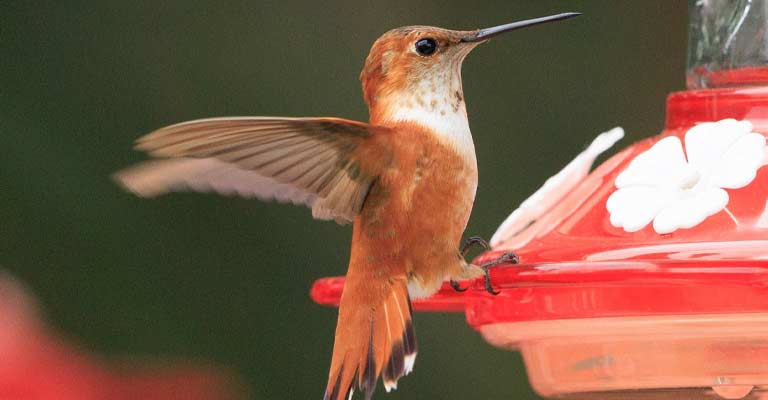
The primary source of sustenance for Rufous Hummingbirds is nectar from a diverse array of flowering plants.
Their specialized bills and long, extendable, tube-like tongues are perfectly adapted for extracting nectar deep within blossoms.
In addition to nectar, these hummingbirds also consume small insects and spiders, providing essential proteins and nutrients, especially during the breeding season when higher energy levels are required.
Habitat
Rufous Hummingbirds are adaptable and can thrive in various environments. They are commonly found in open woodlands, mountain meadows, gardens, and along the edges of forests.
These agile birds are often seen darting among flowers in search of nectar and insects. Their willingness to inhabit diverse habitats contributes to their widespread distribution.
Range Map
The range of Rufous Hummingbirds extends from their breeding grounds in western North America, spanning from southern Alaska to northern California, all the way down to the southern reaches of Mexico.
During migration, these hummingbirds may cover thousands of miles, crossing diverse landscapes and ecosystems.
Nesting
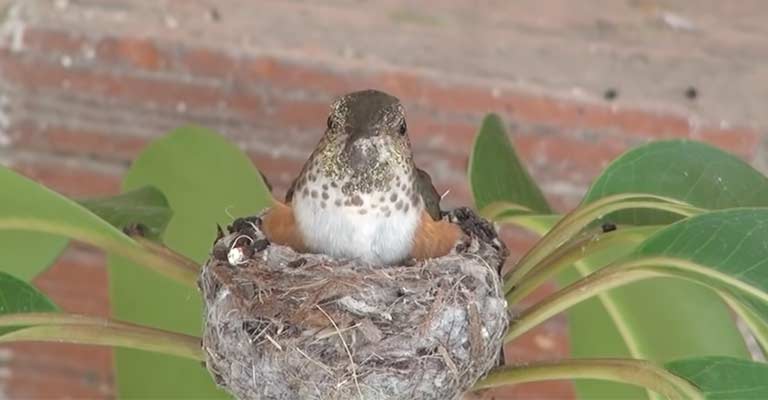
Rufous Hummingbirds are known for their remarkable nesting behaviors. Females construct small, cup-shaped nests using materials like spider silk, plant fibers, and downy substances.
These nests are often attached to the sides of branches, making them inconspicuous. The female is solely responsible for incubating the eggs and caring for the hatchlings.
Nesting Details of Rufous Hummingbird
| Aspect | Details |
| Clutch Size | Typically consists of 2 eggs |
| Number of Broods | Generally raises a single brood per breeding season |
| Egg Length | Approximately 1.0 to 1.3 centimeters (0.4 to 0.5 inches) |
| Egg Width | Around 0.5 centimeters (0.2 inches) |
| Incubation Period | Approximately 14 to 16 days |
| Nestling Period | About 18 to 21 days |
| Egg Description | Tiny, pea-sized eggs with a white or off-white coloration |
| Nest Type | Cup-shaped, constructed using plant fibers, spider silk, and downy substances |
| Nest Placement | Attached to the sides of branches or twigs, often blending with the surroundings |
| Parental Care | The female is solely responsible for the incubation and care of hatchlings |
| Fledgling Stage | Young hummingbirds fledge when they are about 3 weeks old |
| Renesting Behavior | In some cases, females may renest if the first brood fails or conditions are favorable |
| Predator Defense | Females may exhibit distraction displays to draw attention away from the nest |
| Post-Fledging Care | The female continues to feed and care for fledglings for a short period before independence |
The nesting details of the Rufous Hummingbird provide valuable insights into the reproductive behaviors and strategies of this captivating species.
From the delicate construction of their cup-shaped nests to the intricacies of incubation and fledgling care, these aspects contribute to the successful continuation of the Rufous Hummingbird’s life cycle.
Breeding
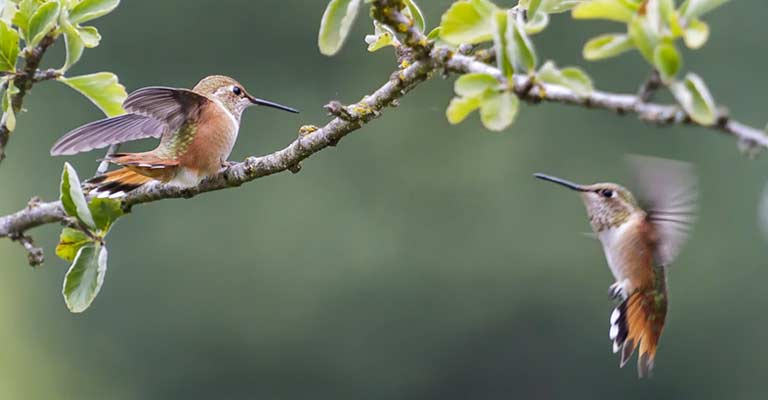
Breeding season for Rufous Hummingbirds typically occurs from late spring to early summer. Males engage in elaborate courtship displays, showcasing their vibrant plumage and performing aerial acrobatics to attract females.
Successful mating results in the female laying two pea-sized eggs. The young hummingbirds fledge in about three weeks, marking the completion of a vital stage in the species’ life cycle.
Diseases
Like many bird species, Rufous Hummingbirds can be susceptible to diseases, with one of the most common threats being avian pox.
This viral infection can manifest as wart-like growths on the skin, affecting the bird’s overall health and potentially leading to death.
Treatment
Treatment for avian pox in Rufous Hummingbirds and other hummingbird species involves minimizing stress on infected individuals, maintaining clean feeding stations to prevent disease transmission, and providing a balanced diet to boost their immune systems.
In severe cases, rehabilitative care from wildlife experts may be necessary.
Conservation
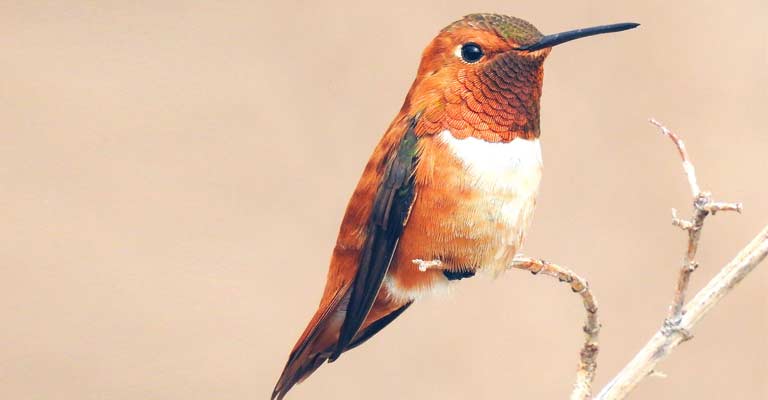
Conserving the Rufous Hummingbird requires concerted efforts to protect its diverse habitats, especially in the face of habitat loss and climate change.
Implementing bird-friendly gardening practices, avoiding pesticide use, and contributing to citizen science initiatives that monitor hummingbird populations are essential steps to the well-being of this enchanting species.
The life history of the Rufous Hummingbird is a testament to its adaptability and resilience.
From foraging on nectar in vibrant mountain meadows to navigating thousands of miles during migration, these hummingbirds embody the beauty and complexity of the natural world.
10 Fun Facts About Rufous Hummingbird
The Rufous Hummingbird (Selasphorus rufus) is a tiny, vibrant marvel of the avian world, known for its striking appearance and lively behavior.
Here are 10 fun facts that highlight the unique characteristics of this captivating hummingbird:
- Incredible Migration: Despite their diminutive size, Rufous Hummingbirds embark on one of the longest migratory journeys of any bird species. They travel thousands of miles annually, from their breeding grounds in North America to wintering locations in Mexico.
- Territorial Warriors: Rufous Hummingbirds are highly territorial and fiercely defend their feeding territories. Males, in particular, engage in aerial battles and aggressive displays to assert dominance over prime nectar sources.
- Extraordinary Flight Skills: These hummingbirds are agile aerial acrobats, capable of rapid and intricate flight maneuvers. Their hovering ability and precision in mid-air make them a joy to observe.
- Vibrant Plumage: The males boast an eye-catching combination of iridescent orange-red throats (gorgets) and vibrant coppery plumage, while females exhibit greenish-bronze colors. This dazzling display serves as a key element in their courtship rituals.
- Feathered Courtship Rituals: To woo females, male Rufous Hummingbirds perform elaborate courtship displays. These displays involve soaring to great heights and then plummeting rapidly, creating a mesmerizing spectacle.
- Energy-Packed Diet: While nectar forms the primary component of their diet, Rufous Hummingbirds also consume insects and spiders for essential proteins and nutrients. Their metabolism is incredibly high, requiring frequent feeding.
- High-Pitched Vocalizations: Rufous Hummingbirds emit distinctive high-pitched chattering sounds during flight and while perched. These vocalizations serve various purposes, including communication and territorial signaling.
- Tiny Eggs: The pea-sized eggs laid by Rufous Hummingbirds are among the smallest in the avian world. Despite their small size, these eggs are crucial to the survival of the species.
- Renowned Renesters: If a nesting attempt fails or conditions are favorable, female Rufous Hummingbirds may engage in renesting behavior, showcasing their resilience and adaptability.
- Natural Pollinators: As they feed on nectar from flowers, Rufous Hummingbirds unintentionally facilitate pollination, playing a vital role in the reproductive cycles of various flowering plants.
These 10 fun facts highlight the remarkable features and behaviors that make the Rufous Hummingbird a fascinating and integral part of the ecosystems they inhabit.
Observing these tiny wonders in action provides a glimpse into the intricate and dynamic world of hummingbirds.
Wrapping Up
The Rufous Hummingbird stands as a testament to nature’s brilliance, with its vibrant plumage, extraordinary migration, and intricate nesting behaviors.
From their territorial battles to the delicate construction of their nests, every aspect of their existence paints a vivid portrait of resilience and adaptability.
As stewards of the environment, appreciating and actively participating in the conservation of these tiny marvels is crucial to ensuring their continued presence and the preservation of the ecosystems they inhabit. Best of luck.